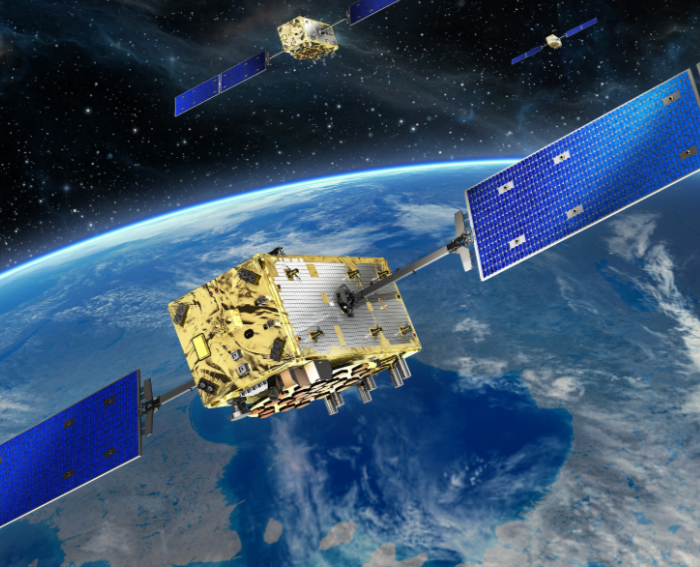Following the recent launch of the first two Galileo Batch 3 FOC (full operational capability) satellites, 24 navigation satellites designed, engineered and integrated by OHB are now orbiting around 23,000 kilometers above the earth. Acting on behalf of the European Commission, the European Space Agency (ESA) awarded the contract for all first-generation satellites to OHB System AG, the principal contractor. Satellites FM 25 & 26 are in the starting blocks and are expected to be placed in orbit in spring 2022. Further satellites are already fully integrated and also waiting in the Bremen Integration Hall. Galileo gives Europe its own satellite navigation system. To mark the recent launch, the OHB team has put together a list of the most frequently asked questions about Galileo, providing brief answers to them.
1. What is Galileo capable of?
The satellites transmit signals that can be received with recent smartphones or navigation devices. On average, Galileo positioning data is accurate down to a distance of 0.92 meters. In addition, Galileo offers a search and rescue (SAR) service, which can also be used in the maritime and aviation sectors. If a ship is in distress at sea, the crew can make an emergency call via a satellite transmitter, which also sends the ship’s position. The Galileo satellite receives the signal and forwards it to the emergency center on the earth to ensure an immediate response.
2. What other applications use the Galileo system?
Standard time references are now possible in banking transactions thanks to the high-precision atomic clocks and the worldwide availability of the Galileo signal. This makes high-frequency trading much safer. In today’s high-frequency transactions, the cause and effect of price movements can only be clearly distinguished and price influences identified when a highly accurate, common time reference is used. Ultimately, it is standard practice nowadays for transactions worth billions to be carried out automatically by algorithms within a few milliseconds. Or put simply, with Galileo, you can be sure whether someone has sold shares because the price has dropped or whether the price has dropped due to the sale. The Galileo service helps to ensure that aircraft landings can be executed with extremely high accuracy and safety, without any need for a complex ground infrastructure.
3. How expensive is a Galileo satellite and how big is it?
A satellite is worth about 40 million euros and is about 15 meters wide when its solar panels are fully extended.
4. Why does Europe need its own navigation system?
For a long time, only the US “Navstar GPS” global positioning system was being used in Europe. However, we now also use the Russian Glonass and the Chinese BeiDou systems. If, for example, GPS were suddenly to stop functioning or were switched off, this would have consequences for the entire economy and infrastructure.
5. So why do we need four global navigation systems?
Even though there are currently no serious global conflicts, no-one can know for sure what will happen in the future. Governments can change their minds at any time, so independence is important and deactivating the systems cannot be used to harm others. As long as this is not the case, all four navigation systems can be used simultaneously and complement each other.
6. Where can I see a list of Galileo-compatible devices?
The latest list is available at https://www.usegalileo.eu//.
7. Are the satellites also used for identifying the location of individual persons?
Don't worry, a normal user’s position is not identified. Imagine you’re sitting in a car and using the navigation device or smartphone for your route. In this case, the device regularly picks up a satellite signal, which it can use to calculate your exact position. A return channel to the satellite is not required for this and, indeed, no such channel is implemented at all. A normal navigation system or telephone cannot transmit data into space (by reason alone of its small size). Nor is this the case with trackers fitted to trucks and cargo. In this case, the position is likewise determined only within the device itself, while an additionally installed GSM module transmits the positioning data via the mobile radio network.
This is not the case with the SAR service. Here, the special hardware required is not fitted to normal positioning devices and mobile phones. Galileo does actually have a return channel in this case, but this makes the devices significantly larger and only small amounts of data can be transmitted in the SAR format. Human lives may depend on this application as the rescue team can only be alerted by means of a return signal, upon which they can immediately start the search and rescue campaign. Since 2020, the control center has also been sending feedback to the emergency caller confirming that the emergency call has been received.
8. When will full capacity be reached with all 34 OHB satellites in orbit?
OHB will be launching another four satellites next year, bringing to 28 the total number of first-generation Galileos in orbit. The launch dates for FM 29 to 34 have not yet been finalized.
9. How long will the satellites continue to operate?
Each satellite has a service life of around twelve years. However, this is only a theoretical figure; technically, there is no limit on the potential lifespan of the satellite.
10. What does it mean for OHB to be part of this major project?
The Galileo project has a terrific team. We started in 2007 with a team of about ten, culminating in about 150 people working on the project in peak periods. We have taken a very flexible and relaxed approach to the project. This spirit has been preserved over all the years and also passed on to new team members. In this way, we have ensured that everyone is motivated and committed. We also look outside the box. Thus, with Galileo, we have developed and brought to fruition a longstanding flagship project for the OHB Group. And that’s something we’re very proud of.




